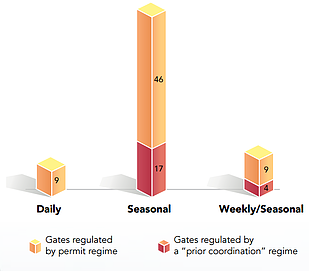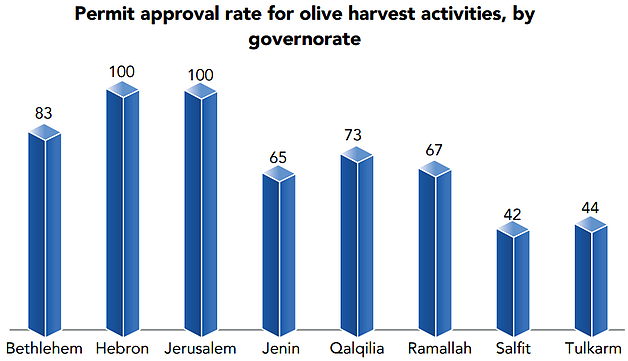2014 olive harvest season: poor yield despite decline in settler violence
Limited access to agricultural land continues to be a challenge
The 2014 olive harvest season, which ended this month, was reported to have proceeded relatively smoothly. Settler attacks against Palestinian farmers and their land declined and there were improvements in access to agricultural land behind the Barrier or located close to Israeli settlements. However, Israeli restrictions embodied in the permit and “prior coordination” regime continue to challenge Palestinian farmers. The olive harvest this year is the second consecutive poor season, primarily due to adverse weather conditions.
Decline in settler violence
This season, OCHA recorded a total of 24 olive harvest-related incidents of settler violence resulting in property damage or injuries, down from the 33 in 2013 and 66 in 2012. Half of the incidents (16) involved the vandalism of 298 olive trees; this is a significant reduction compared with the previous two years (1,522 in 2013; 986 in 2012). Over two-thirds of all incidents took place in the northern West Bank.
In five additional cases (not included in the figures above), Israeli forces denied farmers access to their groves or prevented them from completing harvesting of their olives, which resulted in farmers losing time from the already restricted schedule allocated.
The decline in settler violence may be attributed, at least partially, to the enhanced deployment of Israeli military forces in sensitive areas around Israeli settlements, in some cases alongside staff acting as a protective presence under the coordination of the Protection Cluster.[1] Additionally, the presence of Palestinian farmers and their families in the field was shorter and involved less people than usual due to this year’s poor yield.
Increase in permits to access land behind the Barrier
 A total of 150 Palestinian communities have land located between the Barrier and the Green Line. To access their groves behind the Barrier, farmers are obliged to obtain a special permit or arrange for “prior coordination” with the Israeli authorities. If approved, farmers have to cross designated Barrier gates and checkpoints.
A total of 150 Palestinian communities have land located between the Barrier and the Green Line. To access their groves behind the Barrier, farmers are obliged to obtain a special permit or arrange for “prior coordination” with the Israeli authorities. If approved, farmers have to cross designated Barrier gates and checkpoints.
Most of the crossings along the Barrier are only open during the olive harvest period and only for a limited amount of time on those days, prohibiting year-round access. In total, as of this year’s olive harvest, there were 85 gates[2] designated for agricultural access, of which only nine open daily, 13 open for some day(s) during the week and during the olive season; and the majority, 63, only open during the olive season.
Data obtained by OCHA from Palestinian DCLs across the West Bank indicate that the rate of approval for permit applications to access land behind the Barrier during the olive harvest season was approximately 60 per cent, up from around 50 per cent in 2013. The total number of applications this year declined by seven per cent compared with the previous year, from approximately 15,700 to 14,600. These figures are far lower than the potential number of farmers that could access land behind the Barrier if allowed; this is because, as a rule, people whose applications were denied in the past twice or more stop applying. The highest rates of approval were in the Bethlehem, Hebron and Jerusalem governorates, which contain the smallest areas of land behind the Barrier and therefore, the lowest number of affected farmers.

Limited access undermines productivity[3]
Productivity data collected by OCHA in the northern West Bank over the last five years show that olive trees in the ‘Seam Zone’ have an approximately 60 per cent reduction in yield compared to their equivalent on the ‘Palestinian’ side of the Barrier, where essential activities such as ploughing, pruning, fertilizing and pest and weed management can be carried out collectively by family members on a regular basis.[4]
[1] For further details on protective presence, see OCHA, The Humanitarian Bulletin, September 2014
[2] This figure excludes the seven checkpoints not used to access agricultural land, but used by residents of the “Seam Zone” to reach workplaces and essential services in the remainder of the West Bank.
[3] For more information on produce productivity see OCHA, In the Spotlight: 10 Years since the International Court of Justice (ICJ) Advisory Opinion.
[4] For further details on protective presence, see OCHA, The Humanitarian Bulletin, March 2014.









